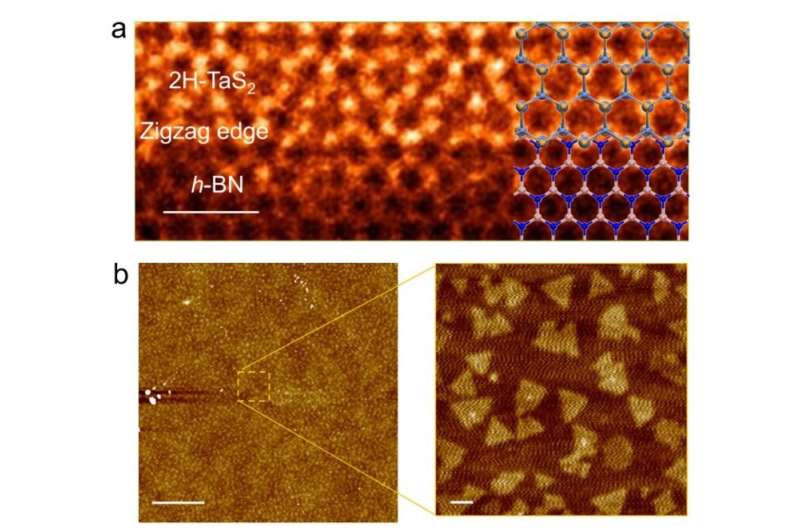Stabilisation of charge density wave phase by interfacial interactions

NUS researchers have demonstrated that the charge density wave (CDW) phase in H-phase tantalum disulfide (TaS2) bilayers can be stabilized at room temperature by interfacial interactions with a hexagonal boron nitride (h-BN) substrate.
Quantum mechanics tell us that all particles behave as waves. The wave nature of particles is particularly evident for particles with very small masses, such as electrons. In some low-dimensional materials, electrons form coherent, periodic waves in the crystal lattice, resulting in wave-like distortions in the atomic lattice called a CDW phase. The CDW phase can exhibit novel phenomena, and has a different electrical conductivity from the usual phase which can potentially lead to new advances in device applications. However, the CDW phase typically exists at very low temperatures. Efforts to increase the CDW phase transition temperature, known as TCDW, have focused on the impact of interfacial strain and charge dopants. However, the effects of such modifications on TCDW have not been significant, because the extent to which the CDW phase is stabilized by such modifications is intrinsically limited.
In this work, Prof Loh Kian Ping's group from the Department of Chemistry, NUS, observed the presence of a CDW phase at room temperature in H-phase TaS2 bilayers when they are epitaxially grown on h-BN substrates. The same CDW phase in bulk TaS2 (without the h-BN substrate) exists only at much lower temperatures, below 77 K. Using quantum mechanical calculations, Prof Quek Su Ying's group from the Department of Physics, NUS, found that the increase in TCDW resulted primarily from interfacial interactions between the TaS2 and the h-BN substrate, and to a lesser extent, interfacial strain.
Scanning transmission electron microscopy and Raman measurements provided evidence for the room temperature 3 × 3 CDW phase for TaS2 when it is epitaxially grown on a h-BN substrate. TaS2 forms a Moiré superlattice with h-BN. In the CDW structure, the lattice arrangement of the sulfur (S) atoms are no longer equidistant from one another, but can be classified into two groups. One group has S atoms that are arranged further from each other (+), while another group has S atoms arranged closer to one another (-).
Density functional theory calculations on 18 different stacking configurations in this supercell show that the tantalum (Ta) and S atoms are always arranged in such a way that the (+) group is centered on the underlying nitrogen (N) atom, while the (-) group is centered on the underlying boron (B) atom. This observation can be understood from the fact that the S atoms carry a slight negative charge in TaS2. They are repelled by the negatively charged N atom in h-BN, and attracted by the positively charged B atom. Thus, the Moiré electrostatic modulation induced by the underlying B and N atoms in the h-BN substrate favor the CDW atomic structure in bilayer (or monolayer) TaS2. This novel mechanism for the stabilization of the CDW phase is confirmed by the experimental observation—that TaS2 randomly oriented on the h-BN substrate does not have a room temperature CDW phase.
Prof Quek said, "In the literature, Moiré interactions in 2-D material heterostructures have resulted in many interesting phenomena. This work shows that the full range of such phenomena is still yet to be uncovered completely. We can use these interfacial Moiré interactions to engineer the quantum phase of 2-D material systems, and this degree of control is what makes atomically thin materials so fascinating."
More information: Wei Fu et al. Room Temperature Commensurate Charge Density Wave on Epitaxially Grown Bilayer 2H-Tantalum Sulfide on Hexagonal Boron Nitride, ACS Nano (2020). DOI: 10.1021/acsnano.0c00303
Journal information: ACS Nano
Provided by National University of Singapore




















